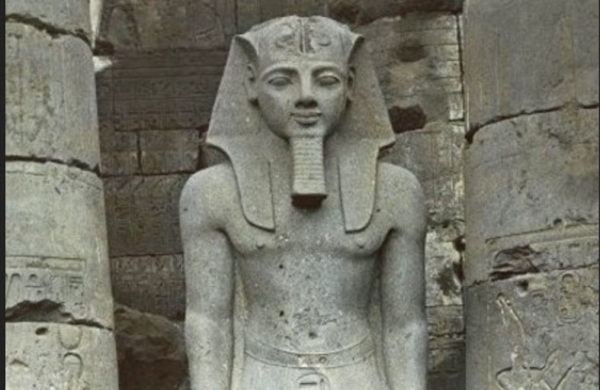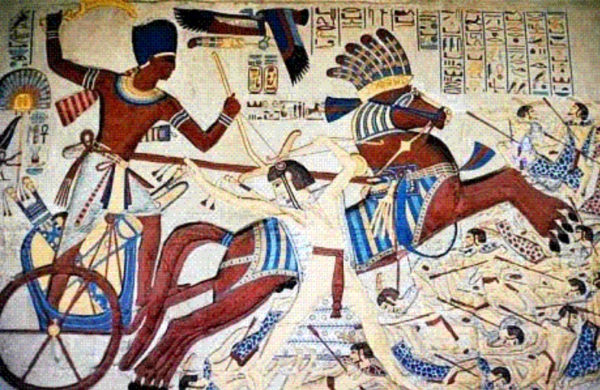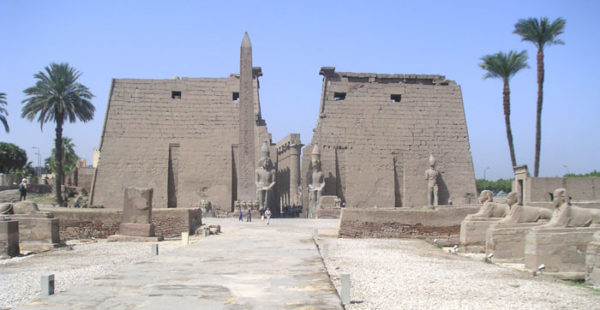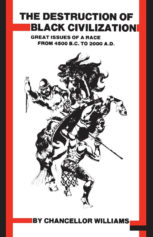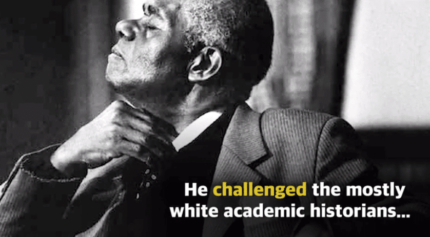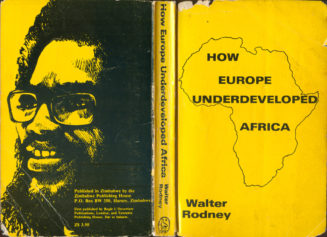Although it was the African Sudan–the “Ethiopia” (Land of the Blacks) of ancient times–that gave birth to the oldest civilization, it is in Kmt (Ancient Egypt), a child of Ethiopia and greatest nation of antiquity, that the bulk of historical research has been done. For the moment, at least, Kmt continues to be the focal point of our African centered researches, and will probably be the object of much of our studies for some time to come. Not only were Ancient Egypt’s origins African, but through the entire Dynastic Age and during all the periods of real splendor from the initial unification of Upper and Lower Egypt in the fourth millennia B.C.E. men and women with black skin complexions and wooly hair reigned virtually supreme.
In the intense and unrelenting struggle to establish and prove scientifically the African foundations of ancient Egyptian civilization, the late Senegalese scholar Cheikh Anta Diop remains a most fierce and ardent champion. Diop, 1923-1986, was among the world’s leading Egyptologists, and held the position of Director of the Radiocarbon Laboratory of the Fundamental Institute of Black Africa in Dakar, Senegal. The range of methodologies employed by Dr. Diop in the course of his extensive labors inc1ude: examinations of the epidermis of Egyptian royal mummies recovered during the Auguste Ferdinand Mariette Expedition for verification of melanin content; precise osteological measurements and meticulous studies in the relevant areas of anatomy and physical anthropology; careful examinations and comparisons of modern Upper Egyptian and West African blood-groups; detailed linguistic studies; analysis of the ethnic designations employed by the Kamites themselves; corroborations of distinct African cultural traits; documentations of Biblical testimonies and references regarding ethnicity, race and culture; and the writings of early Greek and Roman scholars for descriptions of the physical appearances of the ancient Egyptian people.
Diop firmly believed that “The highest point of Egyptian history was the Nineteenth Dynasty of Ramses II.”
Ramses reigned from 1279 to 1213 BCE, more than 3200 years ago. His reign was a time of power and prosperity for the people of Africa’s Nile Valley. The sixty-seven year reign of Ramses the Great was for Kmt an era of general prosperity, stable government and extensive building projects. Ancient deities like Ptah, Re and Set were elevated to high status. The adoration of Amen was restored and his priests reinstated. Major wars were fought with the Libyans, Hittites and their allies. Wondrous temples from Nubia to the Egyptian Delta were carved out of the naked cliffs. Splendid tombs in the hills of western Waset and Abydos were constructed, renovated and beautified. The new Egyptian city of Pi-Ramses made its impressive debut.
Ramses was deified in his own lifetime, and through the unrelenting projection of his own incomparable personality made the name Ramses, the Son of Amen-Re, synonymous with kingship for centuries. Ramses II was truly great. He was the towering figure of his age and established the models and set the standards that others used to rule by.
In regards to the ethnicity of the great Ramses, Cheikh Anta Diop unhesitatingly threw down the gauntlet, and spoke of him in a language of unmistakable firmness and certitude:
“Ramses II was not leucoderm and could have been even less red-haired, because he reigned over a people who instantly massacred
red-haired people as soon as they met them, even in the street; these people were considered as strange beings, unhealthy, bearers of bad luck and unfit for life….Ramses II is black. Let’s let him sleep in his black skin, for eternity.”
Sadly, the mummy of Ramses II has been more than disturbed. In Dynasty XXI the mummies of Ramses II and Set I, along with other royal mummies, were removed from their tombs and reburied in the cliffs at Deir el-Bahari. There the mummies were discovered by the Department of Antiquities in 1881 and removed to Cairo.
Nor, as Diop wished, was the great king allowed to “sleep in his black skin.” He was subjected to many recent observations and experiments. Speaking of the latter, Ivan Van Sertima makes a number of enormously fascinating observations:
“One of the things that struck me most about Diop as a person was his absolute honesty. He was never afraid to criticize something African or black once it merited criticism. I have never found him out in any equivocation or exaggeration. He told me twice, both in London and in Atlanta, that there was no question whatsoever of the blackness or Africanness of Ramses II. He told me that he had actually seen the mummy, and that the skin of the mummy was as black as his skin. He said, however, that after it was subjected to gamma rays the skin looked grayish. It had lost its original dark color. Yet he felt that it would still have been possible to establish its ethnicity through his method, the melanin dosage test. A similar method is now in use in the United States. He said that the scientists involved had used far more gamma rays than was necessary for their experiment. He asked for permission to examine a specimen of the mummy’s skin and hair but he’ was refused permission. The authorities said that it would damage the mummy. Later on, after a certain discovery which was covered up, the scientists abandoned the mummy, suppressed all their reports, and circulated a rumor that this was not really the mummy of Ramses II.”
RAMSES THE GREAT AS MILITARIST: THE KADESH BATTLE
Ramses II never tired of reporting about the battle of Kadesh, The official account of the Kadesh Battle is found inscribed on temples in Abydos, Abu Simbel, the Ramesseum, Karnak, Luxor, and two hieratic papyri. It occurred in the fifth year of his reign near the Orontes River in the Bekaa Valley. At this time the Kamite army was organized into four divisions, each named after one of the chief deities of the realm: Ra, Ptah, Set, and Amen. Included in the Egyptian contingent were the King’s pet lion and two of the monarch’s sons.
Misled by false intelligence reports, Ramses, with only a small personal bodyguard, soon found himself far ahead of the main body of his troops, and it was precisely at this moment that the enemies of Kmt attacked. Near the Syrian city of Kadesh the battle was joined, and it was only Ramses’ personal valor and courage that saved the Kmt army from total disaster. Gathering a small band around him, Ramses charged into the Hittite lines no less than four times and held his tiny force together until the Ptah division of his army arrived on the scene to rescue the situation. The Monarch thought enough of this battle to have it commemorated on monuments throughout the Black Land. Withdrawing towards the west, the Kamites finally signed a treaty with the Hittites which prevailed for the rest of the Ramses’ lengthy reign.
QUEEN OF RAMSES THE GREAT: THE GREAT NEFERTARI
To Ramses II, Queen Nefertari was “The Beautiful Companion.” Nefertari’s two main titles were “King’s Great Wife” and “Mistress of the Two Lands.” The temple of Het-Heru; the northern temple of Abu Simbel, was built by Ramses II to honor this favorite wife, Queen Nefertari. Between the statues of ‘Ramses II are those of Nefertari, and the size of her statues signifies that she will be honored to nearly the same degree as her husband in her relationship to the Deities. Both temples at Abu Simbel were used as storehouses for treasures and tribute exacted from Nubia, thus combining the temples’ essentially religious function with an eminently practical one.
Two building inscriptions are found, one in the main hall, and the other on the facade. The first reads:
“Ramses, he made it as his monument for the Great King’s wife Nefertari, beloved of Mut–a house hewn in the pure mountain of Nubia, of fine white enduring sandstone, as an eternal work.”
The second inscription reads:
Ramses-Meriamon, beloved of Amen, like Re, forever, made a house of very great monuments, for the Great King’s wife Nefertari, fair of face….His Majesty commanded to make a house in Nubia hewn in the mountain. Never was the like done before.”
After her death Queen Nefertari was worshipped as a divine Osirian, or a soul which had become deified, and under the attributes of Asr (Osiris), Lord of the dead, was adored as a god. Nefertari was housed in a 5,200 square foot tomb, the most splendid in the Valley of the Queens.
RAMSES THE GREAT BUILDER: ABU SIMBEL
Ramses II commissioned more buildings and had more colossal statues than any other Kamite king, also having his name carved or reliefs cut on many older monuments. Ramses initiated enormous building activities in Nubia. He commissioned temples at Beit-el-Wali, Gerf Hussein, Wadi-es-Sebua, Derr, Abu Simbel and Aksha in Lower Nubia, and at Amara and Barkal in Upper Nubia. The temple of Abu Simbel, one of the largest rock-cut structures in the world, is no doubt a unique piece of architectural work. It is carved into a mountain of sandstone rock on the left bank of the Nile that was held sacred long before Ramses’ temple was cut there. It was dedicated to Re-Harakhte, the god of the rising sun, who is represented as a man with the head of a falcon wearing the solar disc.
It is a masterpiece of architectural design and engineering. The whole purpose and position of the temple was devoted to the adoration of the sun at dawn, and it was only at sunrise at certain times of the year that the vast interior was illuminated, when the light penetrated the sanctuary. It must have been for the ancients an unforgettable experience to stand in the main hall at dawn and watch the life-giving light of the sun gradually penetrate into the inner sanctum, the Holy of Holies, of an ancient faith.
On the facade of the temple of Abu Simbel are four colossal seated statues cut out of the living rock. The seated statues, two on each side of the entrance, represent Ramses II wearing the double crown of Kmt. The entrance opens directly into the great hall where two rows of four-square pillars are seen. On the front of these pillars are four gigantic standing statues of the king, again wearing the double crown. Each of the seated colossi are sixty-five feet high, taller than the Colossi of Memnon. On the walls of the great hall, which are thirty feet high, there are scenes and inscriptions concerning religious ceremonies and the monarch’s military activities against the Hittites.
The Small Temple of Abu Simbel, contemporary with the Great Temple, was dedicated to the ancient and illustrious goddess Het-Heru and Queen Nefertari. Between 1964 and 1968 both temples were removed to their new location, about 210 miles further away from the river and sixty-five miles higher, at the cost of some ninety million dollars.
PI-RAMSES
For the international concerns of Kmt and for the regaining of the empire, a capital near Asia and the Mediterranean was needed. To Memphis of the White Walls and Waset, Ramses had the ambition and energy to add a dazzling new urban center. The centerpiece of Pi-Ramses was the former summer palace of Seti I which was added to and enriched by Ramses II. Pi-Ramses was also a place where Kmt’s soldiers and chariots could be housed for military readiness.
Ramses took a strong personal interest in the adornment of the city and was constantly in pursuit of new resources for this purpose. He praised himself for his concern for the labor corps working there. He rewarded the overseer with gold as a mark of honor for finding out a block and preparing it for its purpose; he also assured the workmen that he had filled up the storehouse in advance so that ‘each one of you will be cared for monthly. I have filled the storehouse with everything, with bread, meat, cakes, for your food, sandals, linen and much oil, for anointing your heads every ten days and clothing you each year.’”
THE KARNAK TEMPLE COMPLEX
Begun well before the time of Ramses II, the Karnak temple complex grew to become one of the largest sacred sites in the world, encompassing more than 250 acres. The most celebrated and spectacular part of the Karnak temple complex is the grand hypostyle hall. Ramses II completed this hall in a marvelous manner, and it appears as a stupendous forest of columns–exactly 122 of them. The tallest of these columns are about seventy-five feet high, and many of them are decorated with the deeply incised hieroglyphics that became a veritable signature of Ramses II.
THE LUXOR TEMPLE COMPLEX
The magnificent Luxor temple lies just over a mile from the south of the main temple at Karnak. At Luxor, Amen was worshipped in the ithyphallic form of the timeless fertility-god known as Min. The temple is called Luxor, from the Arabic el-Qusur, meaning the Castles, the name given to the village that grew up on the site. The temple is largely the work of Amenhotep III and Ramses II, who added a colonnade court and two obelisks in front of the temple. One remains, the other is in Paris, taken to France in honor of Jean Francois Champollion’s decipherment of Kemetic hieroglyphics. Ramses also had erected at Luxor six colossal statues in his own likeness. Today only four of the statues remain, two seated and two standing.
THE RAMESSEUM
The Ramesseum is the funerary temple of Ramses II located on the west bank of the Nile in Luxor. It was called “The House of Millions of Years of Ramses II in the Estate of Amen.” In the first court of the Ramesseum he set up a granite statue fifty-six feet high, only slightly smaller than the Colossi of Memnon. The gigantic monolith was quarried at Aswan and then ferried down-river to Waset, offloaded, transported several miles to the temple, and erected at the site. Its original weight has been estimated at about 1,000 tons, about three times the weight of one of Hatshepsut’s obelisks at Karnak. It was from the Ramesseum that the English poet Percy Bysshe Shelley (1792-1822) drew the inspiration for the sonnet in which he wrote, “My name is Ozymandias [Ramses II], king of kings; Look on my works, ye Mighty, and despair!” Today, only the head, torso and legs of the statue remain. The rest was destroyed by Christian monks determined to eradicate what they regarded as idolatry.
THE IMMORTAL RAMSES
Having lived vigorously for more than nine decades, Ramses II died in the second month of his sixty-seventh regnal year. There was no final death, however, in the African way of thinking; only gradual decay and periodic renewal. Egypt was perhaps the earliest nation to clearly articulate the purely African notions of resurrection and immortality. As one writer succinctly stated, within the context of Egypt, “If Osiris, the Nile, and all vegetation, might rise again, so might man.” Man could rise, but only if he made God’s words, which were truth, justice and righteousness, manifest on earth. This was fundamental to the African (in this case, Kametic) worldview.
Reclaiming for the African world the ancient Kamite heritage (which of course includes the knowledge of heroic sovereigns such as Ramses the Great), must be seen as an integral part of the Black liberation movement. It will inspire and direct us. Kmt was the heart and soul of Africa, and we need only glance at her noble traditions, her dignity, humanity and royal splendor to measure our true fall from power.
When we examine the civilization of Kmt we note what is perhaps the proudest achievement in all the annals of human history. We must see in Kmt the knowledge that what African people did, African people can do. In this way the great deeds of our illustrious ancestors, including the incomparable Ramses II, are resurrected, and ancient history embraces both what is and what can be, and lays the basis for the forward movement of the African people.
*This brief essay is excerpted from Runoko Rashidi’s, Uncovering the African Past: The Ivan Van Sertima Papers by Books of Africa in London. To reach Runoko Rashidi write to him at [email protected] and visit his new web site at drrunoko.com. His next big group tour is to Italy, Egypt and Sudan in July 2016.

